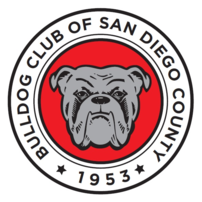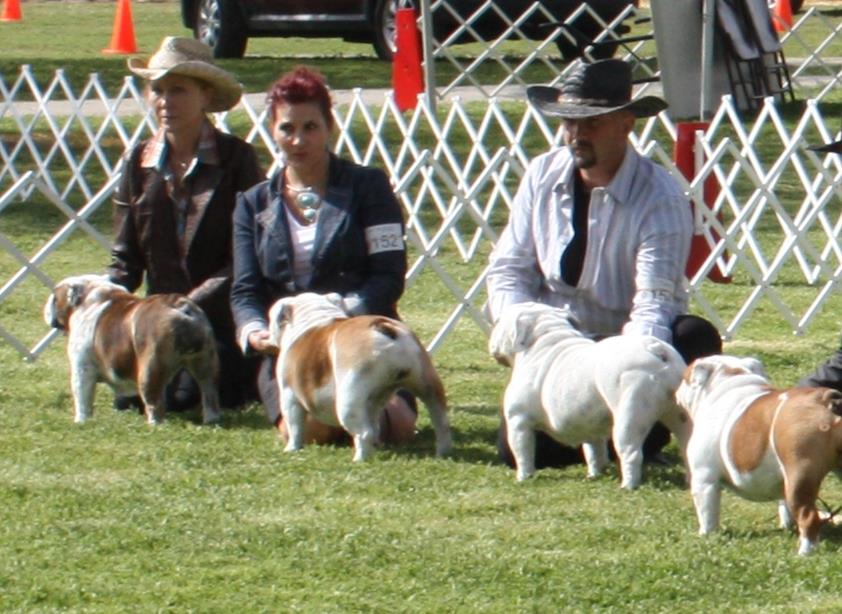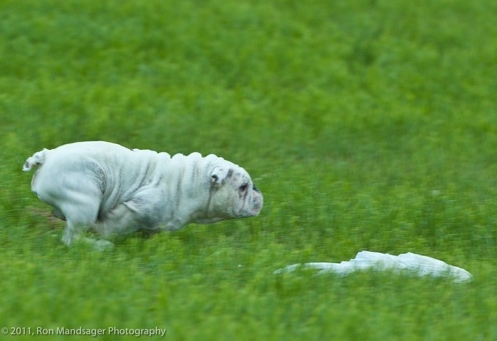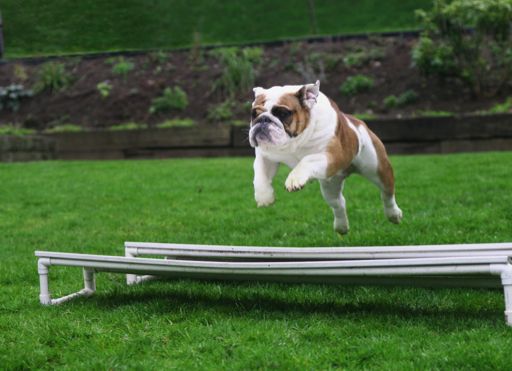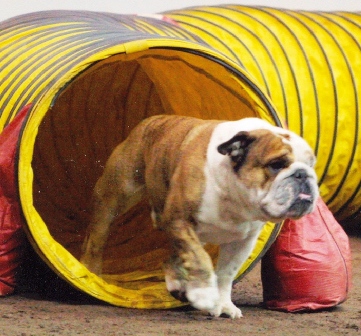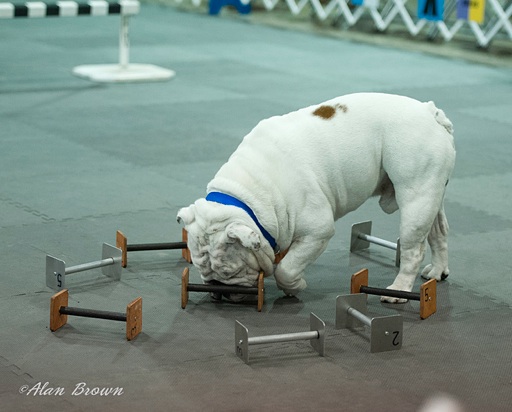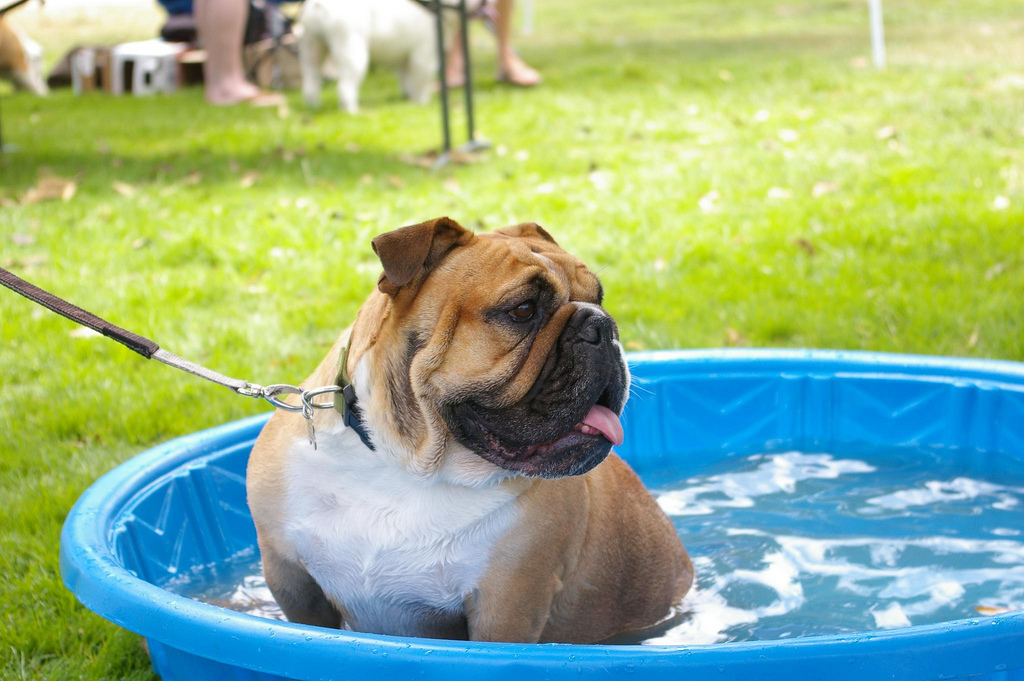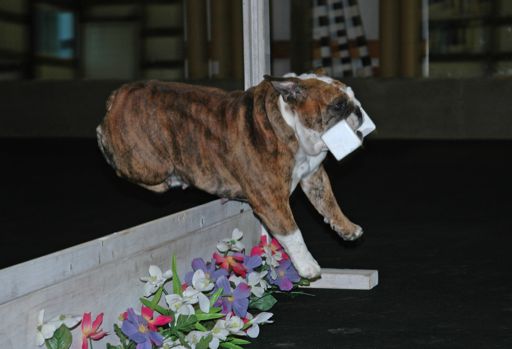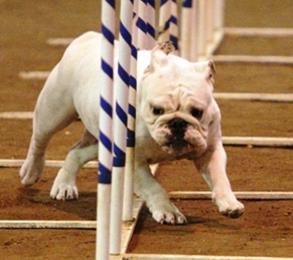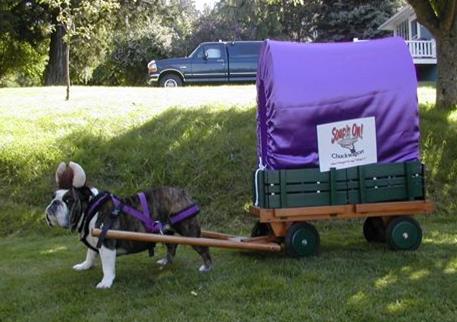The BCSDC hosts a number of events throughout the year which include three AKC sanctioned Bulldog Specialty Shows in February at the Del Mar Fairgrounds concurrent with the huge Silver Bay Kennel Club All Breed Shows. We also participate during our show weekend with a public outreach booth at the Silver Bay Meet the Breed now called the Dog Expo.
We host a Spring Party, a Summer Beach Picnic, Halloween Costume Party, and Christmas Party. Most of our events are held at parks in the city of La Mesa or at the homes of our members. Bulldog lovers and owners are always welcome to attend our parties. We encourage members of SoCal Bulldog Rescue in San Diego County to join us.
Our calendar of events:
Santa Paws Party - Date TBD
Human Holiday Party - Date TBD
February 20 - 22, 2026
BCSDC Specialties Concurrent with Silver Bay Kennel Club
All Breed Shows. Del Mar Fairgrounds, Del Mar, CA
What kind of activities can you do with your Bulldog?
Contrary to popular belief that the Bulldog is a big couch potato with tendencies towards laziness, Bulldogs can be surprisingly active dogs. Depending on the activity level of you and your particular Bulldog, you may be interested in pursuing one of these dog sports! So, get off the couch, take your Bullie along, and get involved with some fun activities in your local area. Given an opportunity, a Bulldog LOVES to show you just how smart and agile they can be.
You can find out more information about these sports on the AKC website at www.akc.org.
AKC Conformation Shows. Southern California is home to a large concentration of All-Breed dog clubs and two local Bulldog clubs, our club, the BCGSD, and Pacific Coast Bulldog Club. As such, there are many weekend conformation shows that can be attended nearly every month of the year. If you visit the Jack Bradshaw Show Superintendent website, www.jbradshaw.com, you can view a list of upcoming shows in California, Arizona, and Nevada. Scroll down the list, find the show you are interested in, and click on the link for that show's particular information. We have a number of club members who actively compete in Conformation and would be happy to help get you started in the right direction. Please contact us bulldogclubsandiego@earthlink.net if you have any questions.
Canine Good Citizen (CGC) - The Canine Good Citizen program is an AKC program to promote responsible dog ownership and to encourage the training of well-mannered dogs. A dog and handler team must take a short behavioral evaluation of less than half an hour; dogs who pass the evaluation earn the Canine Good Citizen certificate. The evaluation consists of ten objectives. All items must be completed satisfactorily or the team fails. Test items include:
If all ten objectives are met, the handler can apply for a certificate and special dog tag from the AKC stating that the dog has earned the CGC title.
Dogs do not have to be registered with the AKC to earn a CGC, nor do they have to be purebred, or in fact, registered with any canine organization. The goal is to promote good citizenship for all dogs.
Obedience - there are three levels of formal Obedience recognized by AKC: Novice, Open and Utility. Each class has increasingly difficult elements.
Novice – For the dog just getting started in obedience. Exercises include:
Open – The second level includes more complicated exercises, which teach the dog to
Utility – The third and highest level of obedience competition. Exercises include:
Rally - Rally Obedience (or Rally) is the new dog sport that is taking the nation by storm. Rally offers both the dogs and handlers an experience that is fun and energizing. It was designed with the traditional pet owner in mind, but it can still be very challenging for those who enjoy higher levels of competition. A rally course is based on Obedience and includes 10 to 20 stations, depending on the level. The canine team moves through a designed course at their own pace. Scoring is not as rigorous as traditional obedience. Communication between handler and dog is encouraged and perfect heel position is not required, but there should be a sense of teamwork between the dog and handler. The main objective of rally is to produce dogs that have been trained to behave in the home, in public places, and in the presence of other dogs, in a manner that will reflect positively on the sport of rally at all times and under all conditions.
Agility - Dog agility is a sport in which a handler directs a dog through an obstacle course of jumps, turns, climbing elements, weave poles, and tunnels in a race for both time and accuracy. It's fast, it's exciting, and the dogs love it! Dogs run off-leash with no food or toys as incentives, and the handler can touch neither dog nor obstacles. Consequently the handler's controls are limited to voice, movement, and various body signals, requiring exceptional training of the animal and coordination of the handler. In its simplest form, an agility course consists of a set of standard obstacles laid out by a judge in a design of his or her own choosing in an area of a specified size. The surface may be of grass, dirt, rubber, or special matting. Depending on the type of competition, the obstacles may be marked with numbers indicating the order in which they must be completed. Courses are complicated enough that a dog could not complete them correctly without human direction. In competition, the handler must assess the course, decide on handling strategies, and direct the dog through the course, with precision and speed equally important. This is a sport that develops and requires incredible communication between dog and handler.
Tracking - Tracking is a technique where dogs are trained to locate objects by using the object's scent, for a variety of purposes. Tracking has always been an essential skill for canines to survive in the wild by scenting, hunting and tracking down potential prey over distance. Today, many police departments have Policy K-9 units with dogs trained to track criminals, and Search and Rescue Organization use trained tracking dogs are to help find lost people. There are three phases which complete the process of tracking:
Searching Phase - This is the phase in which dogs attempt to find a track.
Deciding Phase - Once the dog has found the track, they move more slowly and
Tracking phase - After determining the direction, dogs follow the track by sniffing
Lure Coursing - Though traditionally a sport for specific breeds of dogs to hunt down prey by sight (instead of by smell), many dogs have a strong prey drive and love the thrill of the chase! Lure Coursing was developed to allow Sighthounds to fulfill that natural instinct to chase wild game. However, instead of wild game, a plastic bag or rag is tied to a rope on a pulley system and pulled through a series of twists and turns on a predetermined course. (No live animals are used.) The sport was recently opened up to include all breeds. It doesn’t matter if your dog is a Chihuahua or a Great Dane, or a mix of anything in between, if they love to chase things, they will LOVE Lure Coursing!
Carting - If one is so inclined, you can even work towards an AKC certificate in Carting! Bulldogs are built for the "pull". The dogs are harnessed to a cart and the handler navigates the dog through a pre-designed course with verbal commands while on a lead.
BULLDOG CLUB OF GREATER SAN DIEGO
Links to helpful Bulldog sites:
A dip in the pool at the Summer Picnic
Meet The Breed booth, San Diego Fair
Exhibitors at the BCGSD 2013 Specialty
Waiting to begin the CGS test ...
Beautibully Sittingbullies Pip CD RE aka "Pip", owned by Sherri Feeney & Cheryl Knapp, jumping the broad jump in Open obedience.
Can & Int Ch Sittingbullies Glad Tidings UD RE OAP NJP NAC TN-N CA NDD HIC THD CGC Can CD DD aka "Gabe", owned by Cheryl Knapp, working the scent pile in Utility obedience.
Beefeater's Ode To Joy of SBK UD RE CGC aka "Chubbs", owned by Cheryl Knapp, retrieving over the High Jump in Open obedience.
Red Brick's Wildwood Lyrical Engine CD RN NAP NJP CGC aka "Diesel", owned by Bea & Clay Page, racing out of the Agility tunnel.
Sittingbullies Wildwood Mockingbird CDX VER RE OAP OJP CAX TT Therapy Dog aka "Moxie", owned by Bea & Clay Page, navigating the weave poles.
"Gabe" on the hunt!
"Gracie" with her chuckwagon
To see more of the fabulous Sittingbullies stars, please visit Cheryl Knapp's website at www.GabeRocks.com
2025
2026

